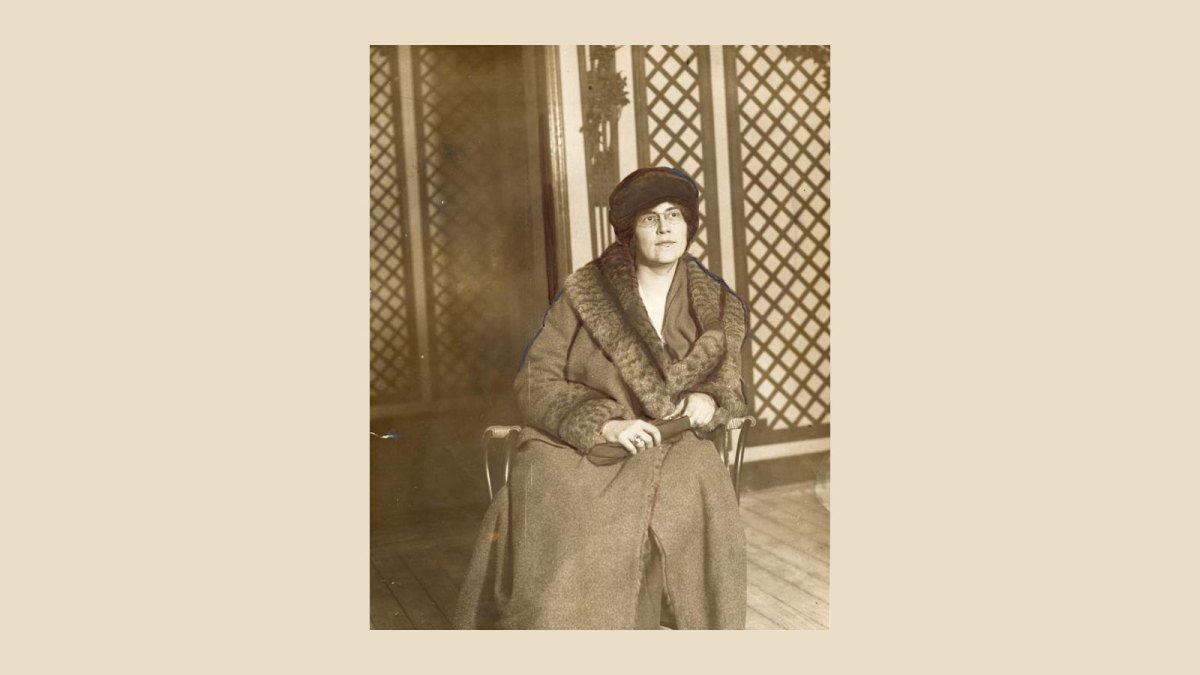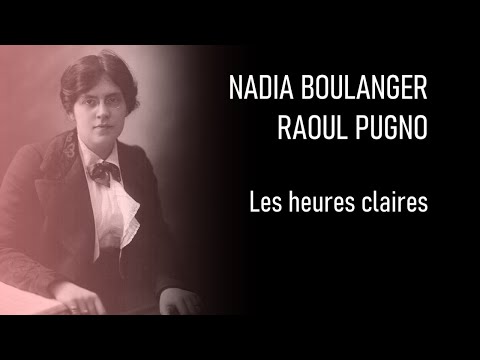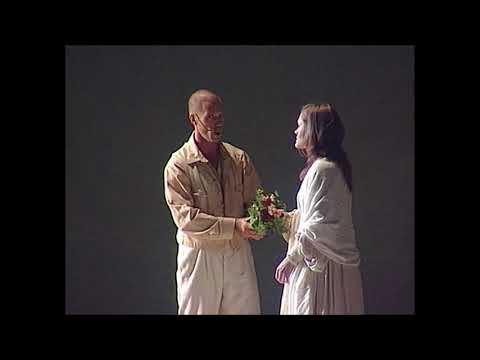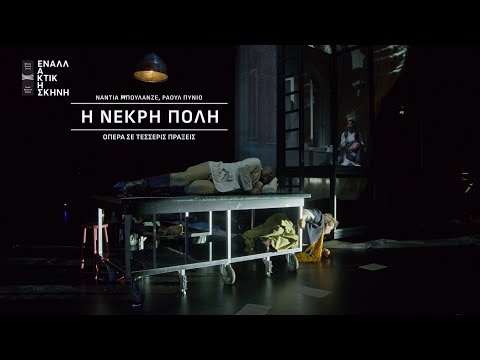Nadia Boulanger was one of the most important teachers of the 20th century, but she was active as a creative artist for only a small part of her long life. Her opera “La ville morte” (“The Dead City”) was begun in 1909; composed in collaboration with her mentor Raoul Pugno, it’s her most substantial work, but has only been performed three times, most recently at the Greek National Opera this month. The Athens performances are a collaboration with the opera company Catapult, who will perform the work in New York in April.
The premiere of “La ville morte” was scheduled at the Opéra-Comique in Paris in mid-1914, but the outbreak of World War I put paid to that plan, and, although there is evidence that Boulanger worked on the opera as late as 1923, it was never performed in her lifetime. The complete orchestral score has not survived.
Pugno was known primarily as a virtuoso pianist, but he was also a composer who worked both solo and collaboratively. He and Boulanger met in 1904 when he was on the jury of a Paris Conservatoire examination she was taking, and he became a friend of the family. In fact, they were so close that the Boulanger family (Nadia, her sister Lili and their mother) spent their summers from 1904 in a property near Gargenville, Pugno’s summer home in a Paris suburb, buying their own house in the district four years later. (There is now a rue Raoul Pugno there.)
Before “La ville morte,” Pugno and Boulanger composed a song cycle, “Les heures claires,” as a team in 1909. The cycle includes eight mostly calm and reflective songs that often evoke Fauré’s style, and have recently been recorded by the French pianist Anne de Fornel and three singers. Pugno and Boulanger’s joint compositional projects inevitably raise questions about who wrote what, and provoked gossip in their day about their relationship: Pugno was a married man and a notorious womanizer. Recently discovered documents reveal that Boulanger and Pugno were indeed lovers, something that in the moral context of early-20th-century France needed to be kept under wraps.
Both their hands are visible on the surviving manuscripts I have studied—it is clear that this truly was a joint composition—but the public’s view of which composer mattered most has shifted. In the early 20th century, Pugno was the big name, and when interviewed about his work, Pugno tended to ignore or minimize Boulanger’s contribution to the opera and the song cycle. Today, the growing wish to situate female creative artists at the center of concert programs means that Boulanger is the primary focus, and while Boulanger’s reputation as a teacher is secure, Pugno is almost completely forgotten. What is clear is that Pugno’s death—in early 1914, while the two musicians were on a concert tour to Russia—was a shattering blow to Boulanger: he was not only a collaborator and close personal ally, but also a performer who championed her compositions. Her compositional career seriously lost momentum after his passing and completely ceased in the early 1920s.
As “La ville morte” does not survive in complete orchestrated form (a vocal score exists), other questions of attribution add further layers of complexity. The performances at the Alternative Stage of the Stavros Niarchos Foundation Cultural Centre, a co-production with Catapult, feature an orchestrated version by Joseph Stillwell and Stefan Cwik. They were commissioned by Catapult’s conductor Neal Goren to prepare a score for 11 instruments under the supervision of David Conte, one of Boulanger’s final students. Moreover, this is a shortened version that cuts an hour from the original length and omits the chorus and a minor role. While this enables the work to be performed in smaller venues, the condensed text and the use of orchestrators only adds to the mystery of who wrote what. While there is no straightforward answer to the question of which bits are by Pugno and which by Boulanger, it is interesting that “La ville morte” is more diverse in musical style than “Les heures claires” and occasionally reflects more contemporary sources of inspiration, suggesting that Boulanger was asserting her individuality more in the opera.
The latest from VAN, delivered straight to your inbox
The libretto is by the Italian poet and novelist Gabriele d’Annunzio, a friend of Pugno’s, based on his five-act 1898 play of the same title. If d’Annunzio is known at all in musical circles, it is as the author of the overheated text of Debussy’s “Le martyre de Saint-Sébastien,” composed in 1911 when Pugno and Boulanger were working on “La ville morte.” But Debussy’s “Pelléas et Mélisande” is much more closely related to their opera: d’Annunzio’s libretto raises the stifling, contained atmosphere of “Pelléas” to a still more extreme level.
The setting is the Greek city of Mycenae in the late 19th century, and this Greek connection gives a sense of homecoming to the Athens leg of its international co-production. The costumes (designed by Candice Donnelly) are roughly contemporary with Boulanger and Pugno’s time, and d’Annunzio’s references to ancient Greek myth provide some focus to the motivations of the opera’s characters. Léonard (tenor Joshua Dennis) is an archaeologist working on the ruins of Mycenae, uncovering tombs and death masks and ashes stored in urns. This is truly a “dead city,” with a rich ancient history and a miserable, parched present-day existence. As in “Pelléas,” the characters constantly sing that they want to escape, but none of them actually do—one of many parallels between “La ville morte” and Debussy’s opera.
The four characters in “La ville morte” are knottily intertwined. Anne, who is blind, spends much of the opera in a state of despair because she knows her husband Alexandre no longer loves her. Alexandre is infatuated with Anne’s close friend Hébé, provoking the jealousy of her brother Léonard, the archaeologist, who harbors incestuous feelings towards his sister while also being the best friend of Alexandre. Hébé is a more passive character: Anne is attracted to her and she tentatively responds to Alexandre’s advances, but she only conveys real passion in her Act III solo in which she identifies with the mythical female characters Antigone and Cassandra. Hébé shares her name with the ancient Greek goddess of youth; Boulanger scholar Kimberly Francis suggests that the young Nadia might have identified with her.
Anne’s house, represented by a raised box-like space in the center of the stage in this production, was the location of much of the action. The small orchestra was to the side and partly hidden, and a huge white cloth was the main focus of the rest of Andromache Chalfant’s serviceable set, concealing props and eventually acting as a shroud. Another connection to “Pelléas” is that Anne is blind but is considered a seer (like Debussy’s Arkel), and the paradox of her situation is abruptly stated at the very end: the final words are “Je vois” (“I see”). Should we take this literally? Or, more likely, has she been aware all along of the other characters’ troubles?
“La ville morte” is an uneven work. Perhaps inevitably given the number of co-creators—two composers and two orchestrators—the variable musical inspiration is striking. Moments where the music blossoms in early Debussy-style impressionist harmony, responding to the evocation of a fountain or the stars, are juxtaposed with pedestrian, anonymous passages: the opening of the final act, when Léonard carried Hébé’s body, was crying out for more engaging musical accompaniment. The composers tend to underline tense moments in the drama with ostinati or string tremolandi above a sustained bass, though often I wanted a stronger edge of menace to accompany the characters’ emotional turmoil.
D’Annunzio’s symbolism is, to say the least, heavy-handed—Alexandre enters carrying a dead bird which he presents to his wife—and the character of Alexandre is weakly drawn. The libretto states that he is a poet, though we hear nothing of his backstory; his declaration of love for Hébé comes out of nowhere. While the four characters’ relationships are intertwined, they never sing together: the impression is of four people who are each obsessed with their own feelings. The opera often comes across as a series of soliloquies, leaving the singers and director Robin Guarino doing their best to inject the sometimes unconvincing material with dramatic momentum.
As Anne, mezzo-soprano Laurie Rubin was the center of the production, omnipresent and seemingly aware of everything around her. Rubin conveyed Anne’s passion as she plunged into Hébé’s long hair (another “Pelléas” parallel), giving genuine human emotions to the rather two-dimensional character. Melissa Harvey (Hébé) showcased her vocal power in her Act III solo, perhaps musically the most accomplished passage: the soaring melodic line was the most memorable moment of the opera, and the aria suggested that Hébé’s identification with Cassandra, the prophet whom no one believed, was stronger than her feelings for the other characters. Joshua Dennis was alive to the complexity of his character and completely on top of the taxing writing of Léonard’s final act soliloquy; he drew as much as possible from the character’s excitement at unearthing an ancient burial ground and creepy obsession with his sister’s purity. Alexandre was portrayed by baritone Jorell Williams, a fine singing actor with a compelling stage presence, who had far too little to do vocally in the last two acts of the opera.
The short fourth and final act focuses on Hébé’s corpse and, in yet another parallel with “Pelléas,” it features a single scene in which all the characters gather around a dead or dying woman. Léonard mourned the sister he had murdered by drowning her; while Alexandre was on stage throughout, he frustratingly had almost nothing to do other than visibly emote. The opera ends abruptly with Anne’s “Je vois,” leaving many dramatic loose ends.
At its best, “La ville morte” is a story of desire and obsession reinforced by music that, in its more picturesque moments, seems to yearn for a brighter and lusher world. The cut-down orchestral accompaniment worked in the small space and the ensemble almost never made me wish they were four times the size.
Anyone who has an image of Nadia Boulanger as a strait-laced teacher will have their preconceptions shattered by the gory, incestuous topic of this opera. Works by her as solo composer, including a large-scale “Fantaisie variée” for piano and orchestra, also hint at what she might have achieved if she had been able to develop her compositional talent. But Pugno’s support was vital to her compositional career, and his loss, rather than the premature death of her sister Lili, was the main factor in her abandoning composition. ¶
Subscribers keep VAN running!
VAN is proud to be an independent classical music magazine thanks to our subscribers. For just over 10 cents a day, you can enjoy unlimited access to over 875 articles in our archives—and get new ones delivered straight to your inbox each week.
Not ready to commit to a full year?
You can test-drive VAN for one month for the price of a coffee.





